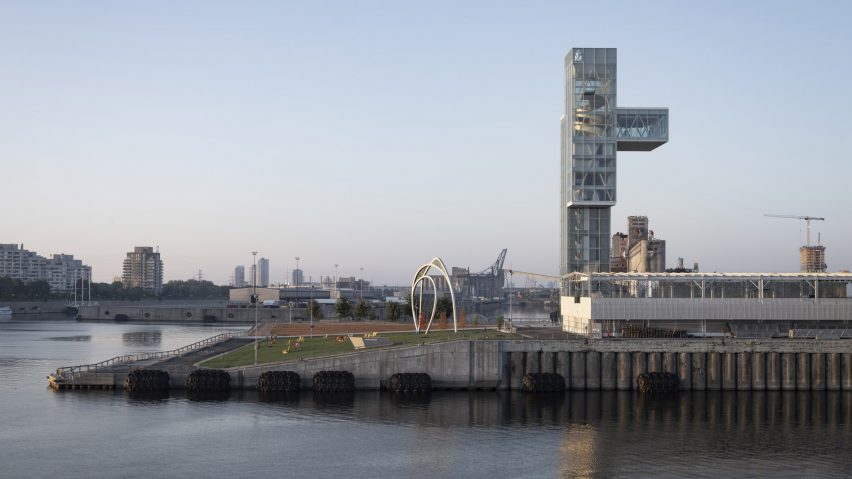Local architecture studio Provencher Roy has included the "lighthouse"-like Port of Montreal Tower with cantilevered platforms in the renovation of a disused industrial pier in Montreal.
Provencher Roy placed the 65-metre-tall tower on the edge of a pier in Montreal's Old City that once served as a grain exporting hub for the region. It now functions as a departure point for cruise ships.
The entirety of the pier was restored by the studio, with the tower rising at the end of a similar horizontal structure that serves as a boat terminal and was completed in 2019.
Called the Port of Montreal Tower, the structure is made of glass and steel and has a series of cantilevers that jut out as it rises. An observation deck protrudes from its side 55 metres off the ground, offering views of the river, the city and Mount Royal mountain.
According to the studio, the tower was meant to serve as a "lighthouse" for both pedestrians approaching the quay by land and for visitors arriving at the city by sea.
"We wanted to make a statement to attract Montrealers to the end of the pier thanks to quality public spaces, beautiful views from the Tower, access to the river, and a space for citizens," said Provencher Roy principal Sonia Gagné.
The glass-and-metal construction of the tower serves a few functions. It allows light to illuminate the tower at night, adding to its function as a "beacon", while creating viewpoints for those inside at multiple points throughout the structure.
"Industrial architecture is based on rationality and forms that are qualified by the need they fill. In this case, the volumetric development is a response to offering visitors and Montrealers an elevated experience, while creating a visual landmark for the Port of Montreal," Gagné told Dezeen.
"The architectural vocabulary developed for the Tower alludes to the area's rich industrial past through its rigorous, expressive structure and compact, pragmatic massing."
The glass facade also allows for daytime passersby to see an expressive staircase inside the structure, an important element of the design.
Described as a "sculptural helicoid", the staircase begins where the two vertical aspects of the tower connect, leading 10 metres up to the observation deck.
It was wrapped in gold-coloured balustrades – meant to reference both the staircases of historic Montreal and the gold of wheat crowns that once filled the industrial silos on the quay.
A platform at the top of the stairs leads to a small, "jewell-like" belvedere – or viewing chamber – that juts out of the facade.
The tallest building around, the tower rises from the end of the restored grounds of the pier – collectively called the Grand Quay – which was organised with the help of landscape architecture studio Nip Paysage.
A restored ferry terminal occupies the majority of the pier and is split in half by a roadway. On one side, where the tower sits, the team created a series of steps that lead to the roof of the terminal.
At the front of a terminal is a large cantilevered volume that serves as an event space.
Green spaces and a wooden walkway lead down and off the terminal roof. This promenade passes greenspaces with native plants, dotted with sculptural light wells that filter light to the terminal below.
The promenade is meant to be the terminus of a series of walking routes that run through the Old City.
It ends in a tree-covered platform with a wooden herringbone-patterned deck and steps on one side. These increase in number as the rest of the pier slopes down from the platform towards a large green space, interspersed with chairs and a monumental sculpture by artist Yann Pocreau.
Other projects by Provencher Roy include a bridge made with recycled glass in Montreal and offices in the city's Olympic Stadium tower.
Photography by James Brittain unless otherwise noted.
Project credits:
Architect: Provencher_Roy
Landscape: NIPPAYSAGE
Structure: NCK
Electromechanical: Pageau Morel
Civil: GÉNIPUR
Maritime infrastructure: WSP Group
Structural glass: Elema
Lighting: CS Design
Consultant: Arup
Builder: Pomerleau

